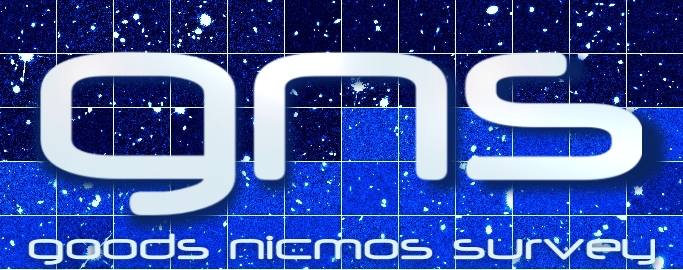Research
Scientific objectives
The GOODS NICMOS Survey (GNS) provides a data
set designed to examine a host of problems requiring very
deep NIR data. The GNS data consist of 60 NICMOS NIC3
pointings, centred on the most massive (M > 10^11 M_sun)
galaxies at 1.7 < z < 2.9. The depth of each image is 3
orbits/pointing within the H160-bandpass over a total area of 45 sq. arcmin.
With these NICMOS data we are able to explore the
rest-frame optical features of galaxies at z > 1 in detail.
This allows a few measurements to be made that cannot be
easily reproduced with optical imagining and/or deep NIR
imaging from the ground.
This includes: filling in the important near-infrared gap in galaxy spectral energy distributions
(SEDs); sampling the rest-frame optical structures and sizes of galaxies out to z~3 and the detection and
characterization of the population of massive z~7-10 galaxies and AGN, and determining the
relation of AGN evolution to that of massive galaxies. In the following we have summarized some of the most
important science goals of the GNS.
Constraining the formation of massive galaxies
- The GNS provides a unique sample of the most massive galaxies at z ~ 1.7 - 3.
- Constrain the number density evolution of massive galaxies in this redshift range.
- Witness the emergence of the red sequence in the colour-magnitude relation.
- Investigate star-formation rates, dust content and the build-up of the stellar mass of massive galaxies.
- Constrain the star-formation rate density and its evolution for galaxies of different stellar mass in this
crucial redshift interval.
Structure and sizes of galaxies in the early universe
- Trace the size evolution of massive galaxies out to a redshift of z~3 and investigate possible causes
like galaxy merging or AGN feedback.
- Study the structures of galaxies in the early universe using galaxy imaging in rest-frame optical
wavelengths.
Galaxy environments at z > 1.5
- The unprecedented depth of the GNS data enables us to investigate galaxy environments up to z~3 for the first
time.
- Investigate correlations between galaxy colour, star-formation rates and local density and compare them to the
local relations.
- Compute merger rates and merger fractions of galaxies of different stellar mass via close pair statistics.
Galaxy stellar mass functions
- Construct stellar mass functions up to z~3.
- Investigate differences in the shape of the mass functions for red and blue galaxies as well as passive and
star-forming objects.
- Trace the build-up of the stellar mass functions of different types of galaxies over cosmic time.
- Reconstruct the stellar mass assembly history of galaxies as a function of environment.
|
|
|





